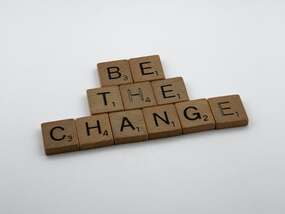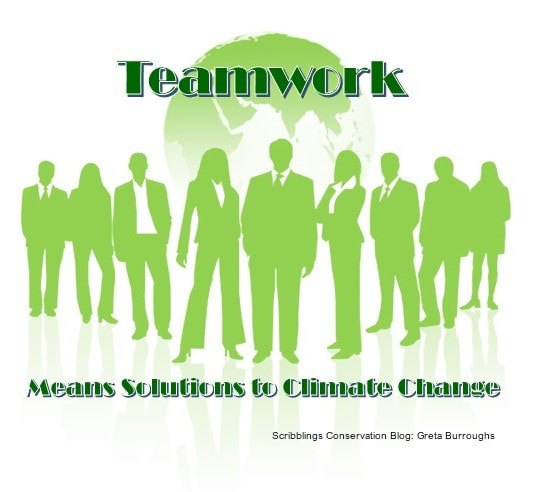
Donna Merrill, the founder of Pollinator Pathways, suggests that the best thing you can do is to do nothing. "Stop worrying about having a manicured lawn. Stop using pesticides. Don't rake your leaves. If a tree falls and presents no danger, leave stacks of woods and brush for pollinators and animals to use as habitat."
In other words, relax and let nature take care of itself.
What if you're not interested in landscaping or gardening? You may not have a yard, or maybe you're not into digging in the dirt. Don't worry about it! You can support conservation and make a positive difference in your little part of the world by educating others about the importance of being good stewards.
Spreading the Word
Donna began her pollinator conservation campaign by walking door to door through suburban neighborhoods giving out free trees and explaining why it was imperative to help the bees, butterflies, and birds. Young and old alike bought into the ideas of incorporating more native plants into their landscape, removing invasive plants, and stopping the use of pesticides.
Word spread to neighboring communities, and Donna's simple act blossomed into a regional network of pathways for pollinators. From there, it continued to expand, eventually reaching other towns and other states. Today, the pollinator corridors stretch from the Canadian border south through nine states.
Follow Donna's lead. Education is the key that transforms an idea into reality — getting your neighbors to understand why they shouldn't rake the leaves or use Round-up™ on those dandelions open doors to teaching them about conservation. Your contagious enthusiasm will spark their interest in attracting buzzing bumblebees and fluttering butterflies to their property. They'll tell their friends, and the cycle continues. Next on your agenda could be organizing events and connecting with garden clubs, community colleges, schools, civic groups, and whoever else will listen. If you're serious about supporting conservation, there are countless activities you can participate in.
Talking with others is an effective way to spread the word without dirtying your hands. And it's as essential and effective as planting native flowers, trees, and shrubs.
Everyday Conservation
Another path open for you is being an example to all your friends and family. Show them how serious you are by taking steps at home that make a difference. Remember, conservation is more than planting flowers. So many issues need to be addressed, such as air, water, and land pollution, global warming, reducing your carbon footprint, plastic pollution, as well as the overuse of pesticides, and the destruction of native habitats and ecosystems.
Be a role model:
- Stop buying single-use plastics – Over 10 million tons of plastic enter the oceans annually, and many more tons are dumped in landfills. Water and soda bottles are significant sources of contamination. Other types of plastic packaging also compound the problem. Everything you purchase, from toys to laundry detergent to food, seems to be wrapped in plastic. Solution: It may cost a little more, but try to find items with as little plastic packaging as possible. As an alternative to water bottles, get a reusable water bottle and refill it from the tap. If you want purified water, get a pitcher with a filter and keep some refreshing cold water in the fridge. When you stop buying all those bottles, not only do you help the environment, you save money too.
- Use glass storage containers instead of plastic – I love salads but hate the soggy, brown lettuce and limp green onion from storing my veggies in plastic bags in the fridge. Solution: I make several days' worth of salads by chopping up and layering my veggies in pint-size canning jars. Even after a week, my salad is still crisp and delicious. I use quart-size canning jars to store the leftover salad fixings. The lettuce, mushrooms, and other goodies keep fresh in the sealed bottles for 3-4 weeks. Can't say that for plastic bags!
- Avoid using plastic/styrofoam utensils and plates – It's so convenient to use those disposable plates and spoons when you're out on a picnic or hosting a BBQ. However, please look for alternatives. Even though they're more expensive, biodegradable disposables could be an option. Old-fashioned paper plates are a pain but are better than clogging up our landfills with plastic garbage that lasts forever. For your picnics, pick up an old-fashioned picnic hamper on Ebay or Etsy. Sure, the hamper has plastic plates and utensils, but they're washable and can be used again and again.
- Do you know your Carbon Footprint? Many of our daily activities - such as using electricity, driving a car, or disposing of waste - cause greenhouse gas emissions. Together these emissions make up a household's carbon footprint. Calculate your family's carbon footprint using the tool provided by the Nature Conservancy.
- Use reusable shopping bags.
- Give up gum. Gum is made of synthetic rubber, aka plastic.
- Purchase cereal, pasta, and rice in bulk and fill a reusable container. You'll save money and unnecessary packaging.
- Avoid buying frozen foods. Their packaging is primarily plastic. Plus, it's healthier; you'll be eating fewer processed foods!
- The EPA estimates that 7.6 billion pounds of disposable diapers are discarded in the US each year. Use cloth diapers to reduce your baby's carbon footprint and save money.
- Reduce, Reuse, Recycle
Now, it's your move.
 RSS Feed
RSS Feed

